On June 22, the Visioning Committee of the Bay State Village Association presented the results (PDF, 6MB) of a recent survey of residents’ preferences for the future of their neighborhood. Below are selected slides from the presentation. Preserving open spaces and the natural environment emerge as clear priorities, as does a desire to maintain current lot sizes (not reduce them). There is also interest in encouraging multi-family homes and working from home.










See also:
Video: Northampton Design Forum – Leeds, Baystate and Florence, 7/27/09
Here are selections from pages 61-62 of Envisioning Sustainable Northampton, produced by the Notre Dame School of Architecture:
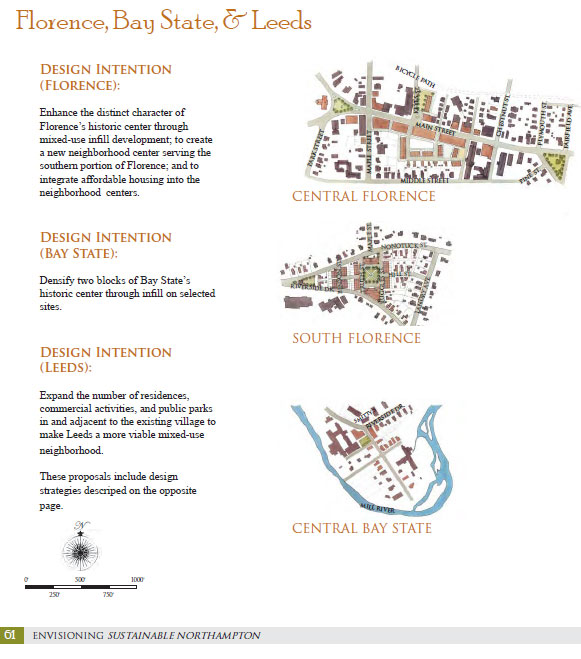
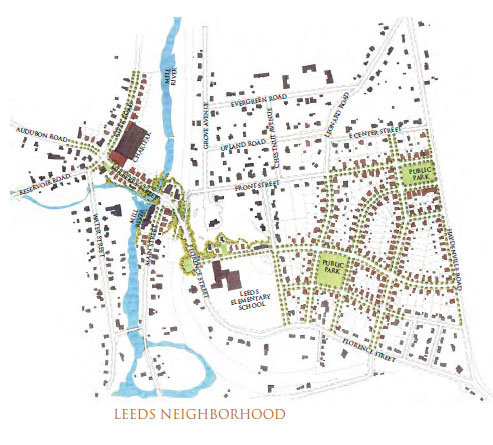
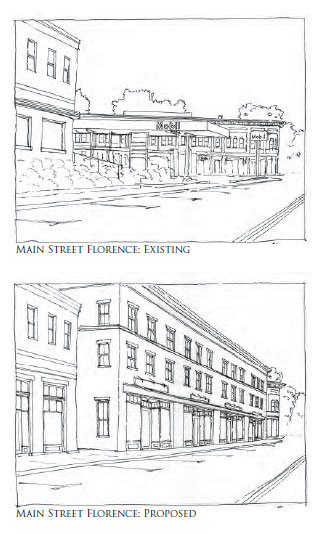
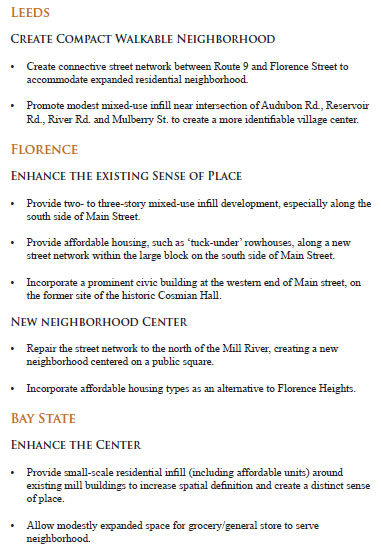
Video: First public “in-process” presentation and feedback session for Design Northampton Week
Fran Volkmann, Vice Chair, Community Preservation Committee
1:09:26-1:10:57
We would like to concentrate development closer in, we like the idea of walkability, bikeability, neighborhood center… The thing that happens to us, however, is that we buy that and then somebody builds some horrible thing…and then they say to you, “This is infill, you know. It’s good, it’s infill.” …You know if you walk in European cities, you very often find little tiny pocket parks, and little bits of green spaces, mixed in with beautiful buildings… How do we…learn to…value…respect for people at the same time that we try to fill in our park spaces?
Video: Planning Board Meeting of 3/26/09; Board Declines to Endorse Zero Lot Line Changes; New Kohl Condo Proposal Discussed
Video time 0:00:00-1:15:30… At 1:11, the Planning Board declines to endorse staff’s initiative to change Northampton’s zero lot line regulations. Issues raised included ensuring the public has a chance to weigh in on specific development proposals and the possible unfairness of changing the rules in zoning districts URB and URC but not URA, even though some URA parcels are close to downtown (infill) areas. The diversity of parcels in URA is making it hard to regulate them all optimally. Planning Board member Katharine Baker: “…sounds like URA is a mess…” (1:15:17) See the Northampton zoning maps for details.
Video: Zero Lot Line Workshop, 3/17/09; Equity of Infill Distribution
Portland: A Photo Tour of Spiraling Densification
In neighborhoods that are still zoned for single family, Portland has reduced the minimum lot size. One result is the “skinny house.” This is not a row house but a 15-foot-wide single-family detached home on a 25-foot-wide lot. Portland held a competition to design innovative skinny houses, but in actual practice they all look almost exactly alike.
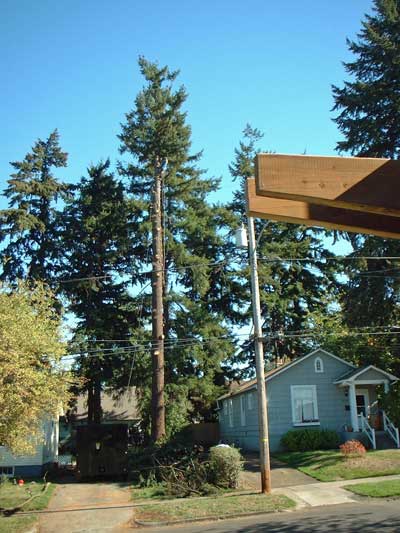
76th before
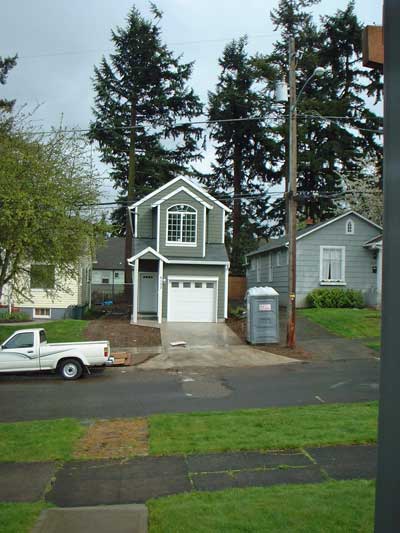
76th after
Proposed Future Land Use Map (PDF)
The orange zones are “Traditional Neighborhood and Receiving Areas”. The light green zones are “Conservation Development and Sending Areas”.
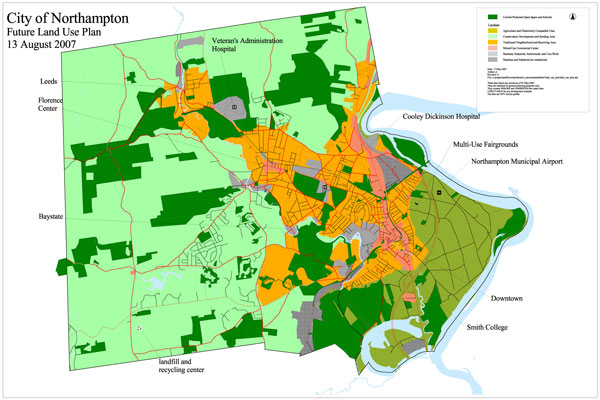
Video: Zoning Revisions Discusses Making Core Urban Neighborhoods More “Conforming”, More Dense (4/22/10)
Rezoning Northampton for a Sustainable Future: Download the Presentation PDF
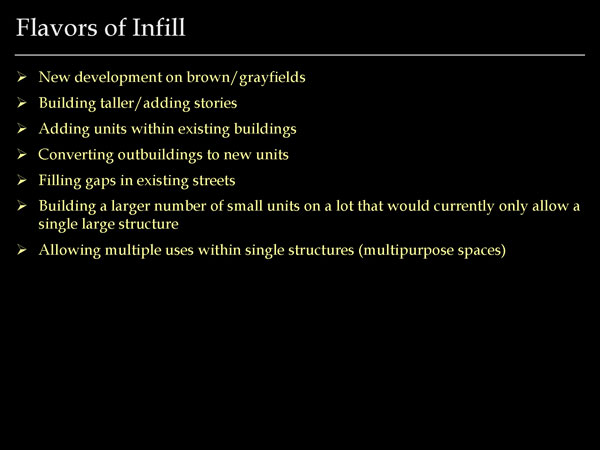
March 10: Zoning Revisions Committee to Meet; Our Suggestions
How will proposed rule changes affect tree canopy ward by ward?
Video: Bay State Village Forum for Mayoral Candidates, 10/21/09; Term Limits; North Street Condo Proposal
Question: “Every town and city in the United States wishes they had more open space in their downtowns, believing that even little parks or open areas make a city more livable. They also attract people who want to live or frequent that city. Seemingly, Northampton does not have the same outlook as other communities. How did the infill theory for growth of the business district morph into an infill theory for all of the residential areas that surround the business district? Besides local developers and real estate agents, how does this infill benefit the current citizens and taxpayers of Northampton who live in these areas?”
Higgins: “I agree with Councilor Bardsley that we need to think about design standards. I think we need to think about density…and I think we need to think about things like greenspace and trees.”
Bardsley: “I think we need design standards… Infill isn’t simply cramming in buildings.”
Video Highlights from the 10/19/09 Mayoral Debate: Wetlands, King Street, Infill and the BID
Letter to Gazette: “Wants a mayor who’ll support green space in town” (10/17/09)
[Eileen Hirsch:] My first encounter with Mayor Higgins was 15 years ago when she was a city councilor at large and our South Street neighborhood was battling with a developer who wanted to convert green space behind our homes into condominiums. It was an area that had no frontage and was utilized for gardens, neighborhood gatherings and recreation. Special zoning ordinances for high-density areas were utilized to circumvent common sense.
Photo Essay: 10 Reasons People Like Trees Around Them; Will the Sustainable Northampton Plan Put Urban Trees at Risk?
…trees around homes in Northampton’s built-up areas (where perhaps half the population lives) may be threatened by proposals in the Sustainable Northampton Plan, which encourages city officials to “implement ideas for maximizing density on small lots” (p.14) and “consider amending zero lot line single family home to eliminate 30′ side yard setback” (p.67).
If you walk down North Street, imagine most trees between houses gone and replaced with a near-solid wall of housing. See the articles below, and decide if that’s growth that’s smart, or growth that smarts…
Smart Growth: When Polls and Reality Diverge
In the [Sustainable Northampton] survey, 90% agreed that “We Should Protect More Open Space & Wildlife Corridors”.
“Green Enhances Growth” by Edward T. McMahon, Planning Commissioners Journal, Spring 1996
…[A 1995 survey by American Lives shows] that “consumers are putting an increasingly high premium on interaction with the outdoor environment through the inclusion of wooded tracts, nature paths, and even wilderness areas in housing developments.” In fact, 77 percent of consumers put “natural open space” as the feature they desired most in a new home development.
Greening Smart Growth: The Sustainable Sites Initiative
The presence of natural elements has several implications for personal and community security. Shared green spaces, particularly those with trees, provide settings for people to interact and strengthen social ties. Residential areas with green surroundings are associated with greater social cohesion in neighborhoods, and neighbors with stronger social ties are more likely to monitor local activity, intervene if problem behaviors occur,[48] and defend their neighborhoods against crime.[49] Residents of buildings with greater tree and grass cover report fewer incidences of vandalism, graffiti, and litter than counterparts in more barren buildings.[50] Likewise, a study comparing police reports of crime and extent of tree and grass cover found that the greener a building’s surroundings, the fewer total crimes were reported.[51]
The Ecological Cities Project: Greenspace in “The Humane Metropolis”
A metropolis (i.e., metro region or citistate) is considered green if it fosters humans’ connections to the natural world — an idea Anne Whiston Spirn promoted in her seminal 1984 book The Granite Garden. Spirn rejected the idea — easily absorbed if one watches too many “concrete jungle” films, or even televised nature documentaries — that the natural world begins beyond the urban fringe. “Nature in the city,” she wrote, “must be cultivated, like a garden, rather than ignored or subdued.”
Berkeley, California: Cautions on Infill
In 1990, 60 percent of New Yorkers said they would live somewhere else if they could, and in 2000, 70 percent of urbanites in Britain felt the same way. Many suburbanites commute hours every day just to have “a home, a bit of private space, and fresh air.”
Vancouver Sun: “Call it EcoDensity or EcoCity –either way it’s a hard sell”
Randal O’Toole: “Smart Growth Doesn’t Just Threaten Urban Areas”
Smart Links: Turning Conservation Dollars into Smart Growth Opportunities, published by the Environmental Law Institute, proposes to use the popularity of public funding for open space to promote smart growth.
Everyone loves open space. To most urban residents, “open space” means city parks. If they think about it, they realize that their backyards also contribute to open space. Large yards also contribute to diverse wildlife habitat and healthy watersheds. But smart-growth goals of high-density housing are incompatible with this form of open space.
When people vote for open space funding, they are not voting to give up their yards. Yet Smart Links proposes that the two be tied together. Specifically, the report urges federal and state distributors of open space funds to only give money to local governments that have adopted and implemented “smart growth development techniques on lands in the jurisdiction that are not slated for conservation.”
City and county officials are highly susceptible to such extortion. They’ll ask their constituents, “Do you want to get open space funds from the federal government?” If the answer is “yes,” they’ll consider it a mandate for high-density, mixed-use zoning.
Our Column in Today’s Gazette: The Hidden Risks of ‘Smart Growth’
The Portland, Ore., metro region is considered a smart growth pioneer, going back to the early 1970s. Portland adopted urban growth boundary restrictions to preserve open space outside the boundary. Transportation initiatives have emphasized public transit over road-building.
Problems emerged, however. With space restricted for building, home prices soared. By 1999, the Portland region was the eighth-least affordable housing market in America, according to the National Association of Home Builders. Pressures for development threaten the remaining greenspace within the boundary: 10,000 acres of parks, fields and golf courses have been rezoned for infill.
Many homebuyers, especially those with children, began to avoid Portland in their quest for affordable, conventional homes with yards. This ironically fostered sprawl (PDF) and traffic as people migrated to cities outside the region’s authority, such as Vancouver, Wash.